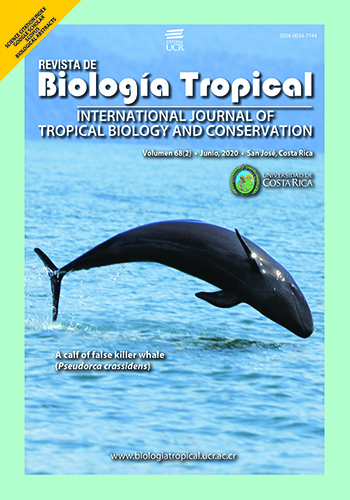Resumen
Introducción: Herbívoros especializados en consumir plantas defendidas por hormigas evolucionaron estrategias para prevenir el ataque de las obreras, que pueden ser específicas o flexibles para repeler obreras de diferentes especies. Objetivos: Estudiamos el comportamiento del chinche herbívoro (Piezogaster reclusus), que consume la savia de árboles de acacia, que se pueden asociar con una de tres especies de hormigas mutualistas del género Pseudomyrmex y reportamos el rango geográfico de las especies de chinches de acacias en Costa Rica y Panamá. Métodos: Evaluamos si los chinches herbívoros (1) se asocian preferiblemente con una especie de hormiga; (2) usan estrategias de comportamiento para evadir a las obreras; (3) ajustan su estrategia a la especie de hormiga residente en la acacia. También, comparamos especímenes de los chinches con especímenes de museos, para clarificar la identificación en Costa Rica y Panamá. Resultados: Los chinches fueron más frecuentes en árboles con hormigas, especialmente Ps. spinicola, y nunca estuvieron en árboles con Ps. nigrocinctus. Los chinches mostraron diferentes comportamientos evasivos dependiendo de la especie de hormiga para prevenir encuentros con las obreras. También, evidencia indirecta de experimentos de transferencia sugiere que hay camuflaje especie-específico o repelencia. Además, reportamos que el límite de distribución de Pi. reclusus llega al centro de Panamá, mientras que Pi. chontalensis solamente está en la región de Chiriquí. Conclusiones: Igual que los herbívoros se especializan en plantas con defensas químicas, herbívoros en plantas con hormigas pueden evolucionar mecanismos específicos para lidiar con las defensas de las plantas. Sin embargo, plantas que se asocian a múltiples especies de hormigas se vuelven un reto para la especialización del herbívoro, y pueden requerir plasticidad de comportamiento como sugieren nuestros datos.
##plugins.facebook.comentarios##

Esta obra está bajo una licencia internacional Creative Commons Atribución 4.0.
Derechos de autor 2020 Sabrina Amador-Vargas






